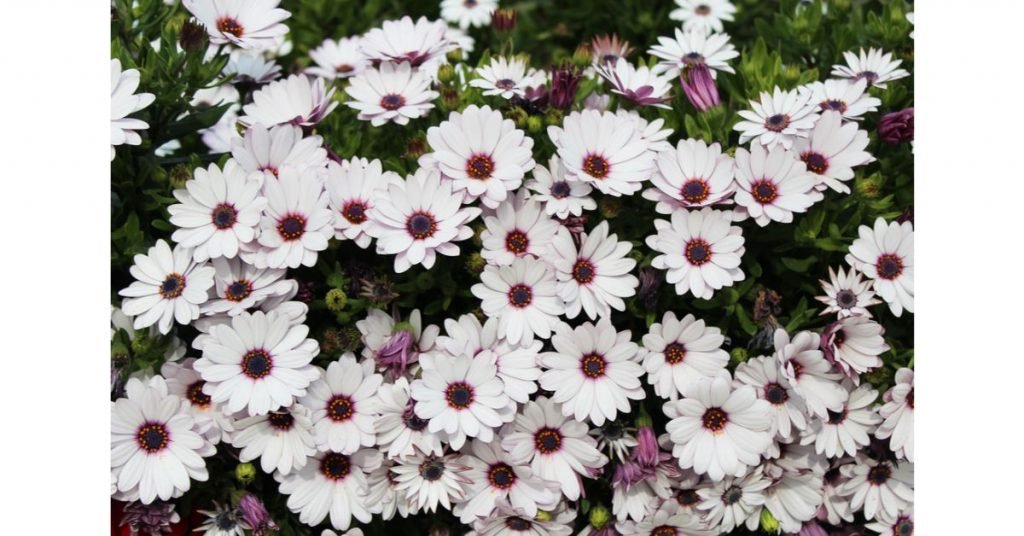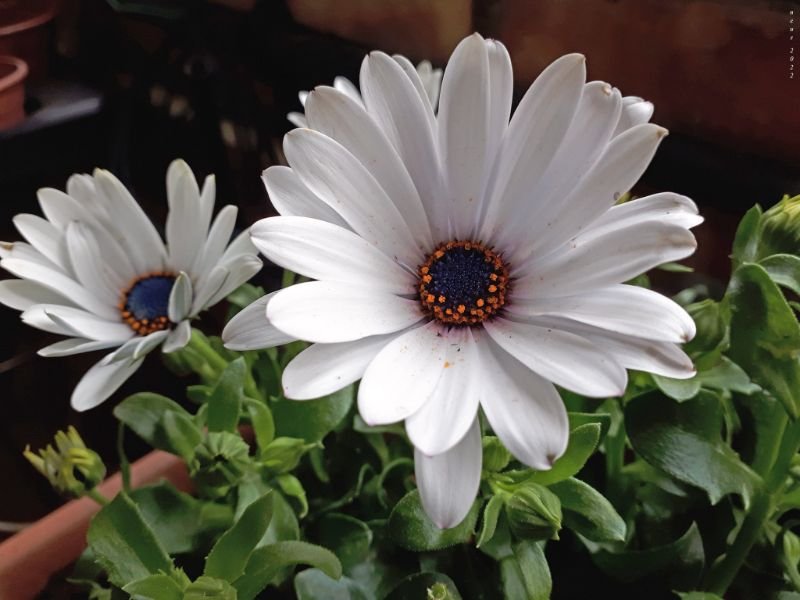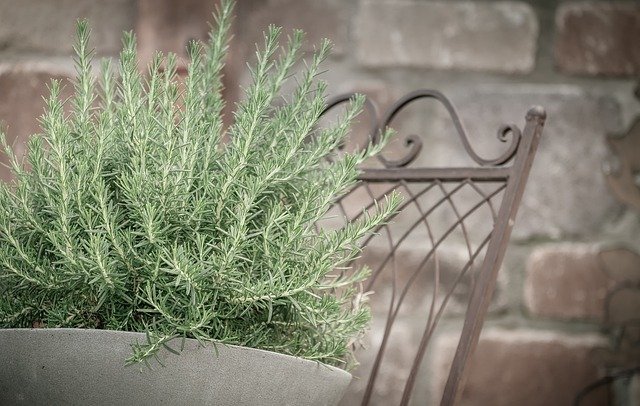The Cape Marguerite (Osteospermum ecklonis), or African Daisy, is a beautiful and versatile plant that is perfect for adding a splash of color to any garden.
Also known as Marguerite Daisy or Cape Daisy this charming flower originates from South Africa and has gained popularity worldwide for its elegant appearance and easy cultivation. Yes, this Daisy is too easy to cultivate resulting in Australia declaring this plant a pest.
With its distinctive blue and white flowers, the Cape Marguerite is sure to add interest to any landscape.

In addition to its visual appeal, the Cape Marguerite is also a hardy plant that is easy to care for. Once established, the Cape Daisy is resistant to drought and heat, making it an excellent choice for gardens in warm climates.
Other popular name of Cape marguerite: African daisy, Van Staden's river daisy, Sundays river daisy, white daisy bush, blue-and-white daisy bush, star of the veldt
Whether planted in mass bedding or used as a border plant, the Cape Marguerite is sure to add beauty and elegance to any home landscape.
Table of Contents
Cape Marguerite Origin
Cape Marguerite Daisy is scientifically known as Dimorphotheca ecklonis (based on Wikipedia) but gardeners more often classified them into Osteospermum since its perennial is an ornamental flower that is originally from the Cape area of south africa. The confusion surrounding its classification arises from the taxonomic relationship between these two genera. In the past, some species were reclassified, resulting in the occasional use of Osteospermum instead of Dimorphotheca in literature.
However, the key distinguishing factor lies in the growth habit and origin. Dimorphotheca species predominantly occur in southern Africa, Angola, and Zimbabwe, while Osteospermum originates from tropical regions of Africa, St. Helena, and the southwest of Saudi Arabia.
The name “Cape” in Cape Marguerite refers to the Cape region, likely referring to the Cape of Good Hope in Africa. The species is named after C.F. Ecklon, an early botanist explorer of the Cape. This connection suggests that Cape Marguerite Daisy has a strong association with the plants found in the Cape region.

The flower’s introduction into cultivation in Europe during the late 1800s further emphasizes its ties to the Cape. Due to the prevalence of Dimorphotheca species in southern Africa, particularly the Cape region, it is fitting that Cape Marguerite is classified within the Dimorphotheca genus.
Cape Marguerite care
This low-maintenance perennial is perfect for hot, sunny border areas and makes an excellent cut flower. It blooms profusely from late spring until the first frost, with showy daisy flowers in shades of white, blue, and purple.

Cape Marguerite light requirement.
cape African daisy (kapmargerit), is a genus of flowering plants native to sub-Saharan Africa. The genus is part of the daisy family (Asteraceae), and Dimorphotheca ecklonis species are characterized by their showy flower heads.
Caring for Cape Daisy is not a difficult task as this plant is very strong in nature. They can easily defeat the harsh environment of Australia which as mentioned before consider this Daisy plant a threat to their local ecosystem. This alone has shown how hardy this flowering daisy can be and how easy is to care for it.
While most Cape Marguerite species require full sun to grow well, some varieties are more tolerant of shade. Cape Marguerite generally needs at least six hours of direct sunlight each day to perform optimally. However, in very hot climates, some afternoon shade may be appreciated to prevent the flowers from scorching.
Once established, the plant is relatively drought tolerant. With its low water needs and tolerance for poor soils, Dimorphotheca or Osteospermum is an ideal choice for xeriscaping or other water-wise landscaping designs.
Cape Marguerite’s watering requirement
Cape Daisy care should include regular watering in order to maintain the health of the plant. Cape Marguerite, as a type of Dimorphotheca ecklonis, thus it has similar watering needs. The soil around Cape Marguerite should be kept moist, but not soggy. Too much water can lead to problems such as root rot.
In general, These plants prefer to be on the drier side, so it is important not to overwater them. If the leaves of the plant start to droop, this is a sign that the plant needs more water. wilting leaves can also be a sign of too much water.
When watering, allow the soil to dry out completely between watering to prevent root rot. fertilize sparingly, using a low-nitrogen fertilizer.
In the winter, cape marguerite will enter a dormant state and will require less water. If you live in an area that experiences freezing temperatures, it is best to grow them in a pot so that you can move them indoors during the coldest months.
Thus, it is important to check the leaves regularly and water them accordingly.
Cape Marguerite’s preference for growing zone and condition

Cape Marguerite evergreen shrub or small tree can reach a height of 20 feet but is typically seen between 6 and 10 feet tall. It prefers full sun and well-drained soils, making it a good choice for hillside plantings.
This plant is drought tolerant once established but will benefit from supplemental irrigation during extended periods of dry weather.
Cape Marguerite blooms from June to August, with white or pink flowers that are attractive to bees and butterflies. The fruit is a small black berry that is poisonous to humans but beloved by birds.
For best results, plant Cape Marguerite in USDA Hardiness Zone 9.
Cape Marguerite soil and mineral need
Cape Marguerite plants are native to the Cape region of South Africa. They are drought and heat-tolerant and can grow in a wide range of soil types.
However, they do prefer well-drained soils with high levels of organic matter. The ideal pH range for Cape Marguerite plants is 5.5 to 7.5.
Cape Marguerite plants need a moderate amount of fertilizer, and they should be fertilized three times a year – in spring, summer, and autumn. In terms of minerals, Cape Marguerite plants need iron, magnesium, and manganese. They also benefit from occasional applications of compost or manure.
Those standard procedures for caring for cape daisies will ensure you will get the maximum result from your daisy plant. But if you want a scientific-based hack on how to grow Cape Marguerite Daisy even better, we got you covered. Our next section will provide you with more details on this.
Optimizing Growth and Flowering
Water and soil moisture are crucial for the growth and development of cape marigold plants.
In a recent study by Bioscience Research, researchers found that maintaining a soil moisture level of around 20% depletion of available water resulted in significant improvements in plant growth and flowering.
Additionally, incorporating biochar into the soil had a positive impact on cape marigold plants, with the highest dose of biochar showing the greatest improvements. Biochar improves soil properties and enhances plant growth. By combining optimal soil moisture levels and increased biochar amounts, gardeners can create an ideal environment for cape marigolds to thrive, resulting in higher-quality and more abundant flowers.
Alternatively, if gardeners are interested in early flowering, a slightly drier soil environment may be considered.
The study found that the lowest soil moisture level, around 50% depletion of available water, triggered the earliest blooming in cape marigold plants.
Plants subjected to the lowest soil moisture level started flowering significantly earlier than those with higher moisture levels. This could be attributed to the water shortage in the low moisture treatment, which hindered vegetative growth but stimulated reproductive growth. As a result, the plants went through their life cycle faster and displayed signs of early flowering.
Cape Marguerite’s growing habits
The Cape Marguerite, or African Daisy, is a herbaceous perennial native to South Africa. It is a member of the daisy family and has showy white flowers with yellow centers that bloom throughout the summer months.
Cape Marguerite’s growing stages

Cape Marguerite’s growth cycle is fascinating to watch.
The plant starts out as a tiny seedling, no bigger than a blade of grass. Over the course of several months, it slowly grows taller and taller, Eventually reaching a height of several feet.
The leaves of the plant also change over time, shifting from a deep green to a bright yellow.
Finally, the plant produces beautiful white flowers, which attract bees and other pollinators.
After blooming, the flowers gradually turn brown and fall off the plant. The flower has some color variations most often purple to navy center and can grow up to 6 inches in diameter. The plant itself can grow up to 3 feet tall and has a very dense growth habit.
Once the cycle is complete, the plant begins to prepare for its next growth cycle.
Cape Marguerite’s expected age? is it annual or perennial?
Cape Marguerite is a beautiful and unique plant that is known for its stunning white blooms.
Cape Marguerite typically blooms from late spring to early summer, and it is a perennial plant that can live for several years.
The expected age of a Cape Marguerite plant is two to three years, but it can occasionally live for up to five years with proper care.
Cape Marguerite’s flowers’ characteristics
Cape Marguerite’s flowers are commonly called daisies. They have white petals with a yellow center. The flowers grow in clusters and are about 2 inches in diameter.
African daisies’ flower heads are actually composed of many small flowers called florets. The outer florets are sterile and lack ray petals, while the inner florets are fertile and have both ray and disc petals.
Cape Marguerite is a member of the Asteraceae family, which also includes sunflowers, chrysanthemums, and zinnias.
Are Cape Marguerite’s indoor or outdoor plants?
Cape Marguerites are beautiful plants that can bloom year-round with the right care. They are originally from South Africa, so they are used to warm climates.
However, they can adapt to cooler temperatures and even tolerate some frost. This makes them versatile plants that can be grown indoors or outdoors.
Marguerite or African daisies that are grown indoors should be placed in a sunny location, and they should be given moderate amounts of water. If you are growing Cape Marguerites outdoors, they will require little to no supplemental watering once they are established.
Cape Marguerite’s pruning
Cape Marguerite can grow to be up to six feet tall and wide, making it a perfect choice for use as a hedge or privacy screen. Pruning is one of the ways for caring Cape Marguerite.
Pruning is the only real maintenance that this shrub needs. It should be pruned in late winter or early spring before new growth begins. When pruning, be sure to remove any dead or damaged branches.
You can also shape the shrub by pruning back any longer branches. Overall, pruning is a very simple task that will help keep your Cape Marguerite looking its best.
Cape Marguerite’s propagation
Cape Marguerite is often grown as an ornamental plant in gardens and landscaping. It can be propagated by seed, but it is better to propagate it by root cuttings.
Here are how you can propagate Cape Marguerite by the root:
- To take root cuttings, find a healthy plant and carefully dig up a section of the root system.
- Cut the roots into 2-3 inch pieces and plant them in well-drained soil.
- Water the roots well and keep them moist until they develop new growth.
- Once the new growth appears, you can transplant the rooted cuttings into their permanent location.
Grow Cape Marguerite’s from seeds
Growing cape marguerites from seed are not difficult, but it does require some patience.
- The seeds must be started indoors, in a sunny location, 6-8 weeks before the last frost date.
- Sow the seeds thinly on the surface of a well-draining seed-starting mix, and cover them with a thin layer of sand.
- Keep the soil moist but not wet, and provide plenty of light. Once the seedlings have emerged, thin them to one per pot, and transplant them into the garden after all danger of frost has passed.
- Cape marguerites are heat-loving plants, so choose a location in full sun for the best bloom production.
- Deadhead regularly to encourage continuous flowering. Caring for a newly grown cape marguerite will bring joy to your gardening adventure.
COMMON Diseases and pests of CAPE MARGUERITE
Cape Marguerite is a common flower in many gardens, but it can be susceptible to diseases and pests. Here are some of the most common problems:
- Powdery mildew is a fungal disease that causes a white powdery growth on the leaves and stems of cape marguerite. The disease can weaken the plant and reduce its vigor, so it’s important to treat it early.
- Aphids are small sap-sucking insects that can infest cape marguerite. They can cause stunted growth and distorted leaves, and they can also spread diseases. To control aphids, you can use insecticidal soap or horticultural oil.
- Mites are tiny spider-like creatures that feed on the chlorophyll in plant leaves. This can cause the leaves to turn yellow or brown and eventually drop off. Mites are difficult to control, but you can try using an insecticide or miticide.
- Thrips are small winged insects that feed on the sap of cape marguerite flowers. This can cause the flowers to become discolored and distorted. To control thrips, you can use an insecticide or trap them with yellow sticky traps.
Cape Marguerite’s benefits
Cape Marguerite plants are commonly used as ornamental plants in gardens and landscapes due to their showy flowers.
Cape Marguerite plants are well-suited to hot, dry climates and can tolerate poor soil conditions. These tough plants are also resistant to drought and frost.
In addition to their attractive flowers, Cape Marguerite plants also offer a number of benefits for the garden. For example, they can help to attract pollinators such as bees and butterflies.
They can also provide ground cover, helping to prevent soil erosion. Caring for a Cape Marguerite can indeed produce many benefits not only for the plant lover but also the nature.
With their numerous benefits, it is no wonder that these plants are such popular garden choices.

Gardening is my passion and growing plants indoors has always been a stress relief for me. Grow a banana tree in my apartment once (although failed to produce bananas).






